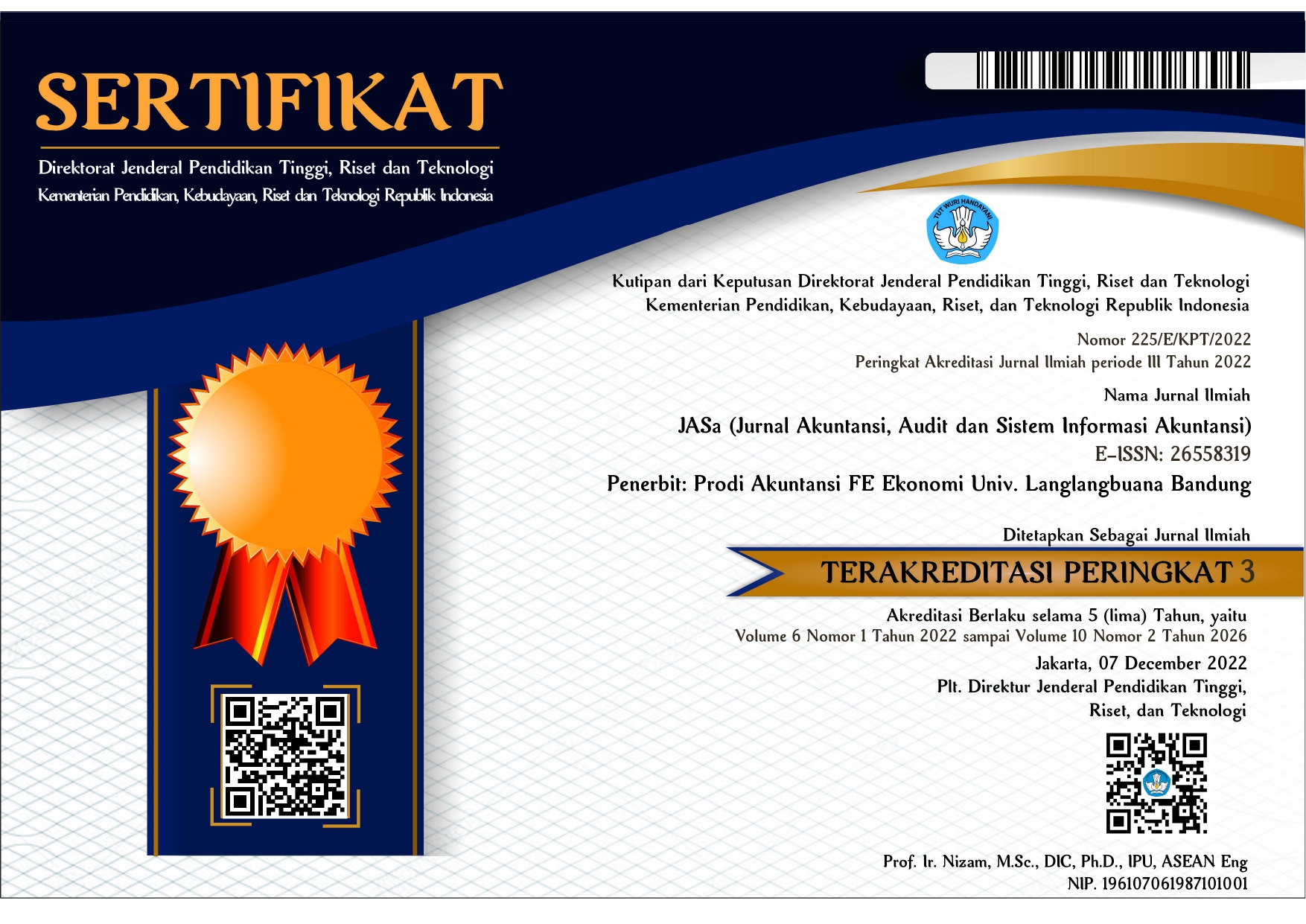Herding Behavior, Loss Aversion Bias, Financial Literacy, and Investment Decisions (a Study on Millennial Generation in Indonesia in the Digital Era)
DOI:
https://doi.org/10.36555/jasa.v7i3.2301Keywords:
HERDING BEHAVIOR, LOSS AVERSION BIAS, FINANCIAL LITERACY, MILLENIALAbstract
In the last few years in Indonesia, many investment applications have emerged where these applications make it easy for investors to be able to invest. The emergence of investment applications also raises many problems such as fraud under the guise of investment and people in Indonesia, especially young people who are easily tempted by investment offers that provide high returns so that they often carry out investment activities but are irrational and tend not to look at financial conditions in making investments. The purpose of this study is to see how the internal and external factors of an investor, especially the millennial generation, in making investment decisions, namely the factors of Herding Behavior, Loss Aversion Bias and Financial Literacy. This research method uses descriptive and verification methods with a sample size of 400 respondents and data analysis techniques using Multiple Logistic Regression Analysis. The results showed that the the Herding Behaviour variable has a positive effect on Investment Decisions of the Millennial Generation in Indonesia in the Digital Age, Loss Aversion Bias has a negative effect on Investment Decisions of the Millennial Generation in Indonesia in the Digital Age, while the Financial Literacy variable has no effect on Investment Decisions of the Millennial Generation in Indonesia in the Digital Age.
References
Adielyani, D. and Mawardi, W. (2020). The Influence of Overconfidence, Herding Behavior, and Risk Tolerance on Stock Investment Decisions: The Empirical Study of Milenial Investors in Semarang City. Journal Maksipreneur, 10(1), p. 89. doi:10.30588/jmp.v10i1.691.
Adil, M., Singh, Y., & Ansari, Mohd. S. (2022). How financial literacy moderate the association between behaviour biases and investment decision? Asian Journal of Accounting Research, 7(1), 17–30. https://doi.org/10.1108/ajar-09-2020-0086
Annur, C. M. (2021, December 13). Investor Pasar Modal Didominasi Milenial. Katadata.Co.Id. https://databoks.katadata.co.id/datapublish/2021/12/13/investor-pasar-modal-didominasi-milenial.
Awais, M., Laber, M. F., Rasheed, N., & Khursheed, A. (2016). Impact of Financial Literacy and Investment Experience on Risk Tolerance and Investment Decisions: Empirical Evidence from Pakistan. International Journal of Economics and Financial Issues, 6(1), 73–79. https://www.econjournals.com/index.php/ijefi/article/view/1414
Bernheim, B. D., Garrett, D. M., & Maki, D. M. (2001). Education and saving: The long-term effects of high school financial curriculum mandates. Journal of Public Economics, 80(3), 435–465. https://doi.org/10.1016/S0047-2727(00)00120-1.
Chen, H., & Volpe, R. P. (1998). An Analysis of Personal Financial Literacy Among College Students. Financial Services Review, 7(2), 107–128. https://doi.org/10.1016/S1057-0810(99)80006-7
Creswell, John W. (2012). Research Design Pendekatan Kualitatif, Kuantitatif, dan Mixed. Yogyakarta: Pustaka Pelajar
Dewan, P. & Dharni, K. (2019). Herding Behaviour in Investment Decision Making: A Review. Journal of Economics, Management and Trade, 24(2), pp. 1–12. doi:10.9734/jemt/2019/v24i230160.
Dihni, V. A. (2022, February 22). Kerugian akibat Investasi Ilegal di Indonesia Capai Rp117 Triliun. Katadata.Co.Id. https://databoks.katadata.co.id/datapublish/2022/02/22/kerugian-akibat-investasi-ilegal-di-indonesia-capai-rp117-triliun
Ghozali, Imam. (2018). Aplikasi Analisis Multivariate dengan Program IBM SPSS 25. Semarang : Badan Penerbit Universitas Diponegoro
Hasan, I. (2009). Analisis Data Penelitian Statistik. Jakarta: Bumi Aksara.
Heizer, J., & Render, B. (2017). Operations Management, Buku 1 edisi ke sebelas. Jakarta: Salemba Empat.
Khalid, R., Javed, M. U., & Shahzad, K. (2018). Impact of Behavioral Biases on Investment Decision Making with Moderating Role of Financial Literacy. Jinnah Business Review, 6(2), 34–41. https://doi.org/10.53369/rkxa7855
KSEI. (2022). Ada 4 Juta Investor Saham di Indonesia sampai Juni 2022. Indonesia. https://databoks.katadata.co.id/datapublish/2022/07/11/ada-4-juta-investor-saham-di-indonesia-sampai-juni-2022
Michelmores. (2019). Milenials, Money & Myths. United Kingdom : Michelmores.
Pompian, M.M. (2006) Behavioral Finance and Wealth Management How to Build Optimal Portfolios That Account for Investor Biases. New Jersey: John Wiley & Sons.
Pompian, M. (2012). Behavioral Finance and Investor Types: Managing Behavior. Hoboken, NJ: John Wiley & Sons.
Sekaran, Uma & Roger Bougie. (2016). Research Method For Business: A Skill Building Approach 17th Edition. Chichester: Wiley
Son, J., & Park, J. (2019). Effects of financial education on sound personal finance in Korea: Conceptualization of mediation effects of financial literacy across income classes. International Journal of Consumer Studies, 43(1), 77–86. https://doi.org/10.1111/ijcs.12486
Sugiyono. (2017). Metode Penelitian Kuantitatif, Kualitatif, dan R&D. Bandung: Alfabeta.
Supardi, S. (1993). Populasi dan sampel penelitian. Jurnal Fakultas Hukum UII, 13(17), 100-108.
Syafina, D. C. (2019, July 22). Mengapa Generasi Milenial Sulit Mengelola Keuangan. Tirto.Id. https://tirto.id/mengapa-generasi-milenial-sulit-mengelola-keuangan-eeDV
Utami, N., & Sitanggang, M. L. (2021). The Analysis of Financial Literacy and Its Impact on In-vestment Decisions: A Study on Generation Z in Jakarta. Inovbiz: Jurnal Inovasi Bisnis, 9, 33–40. https://doi.org/10.35314/inovbiz.v9i1.1840.







